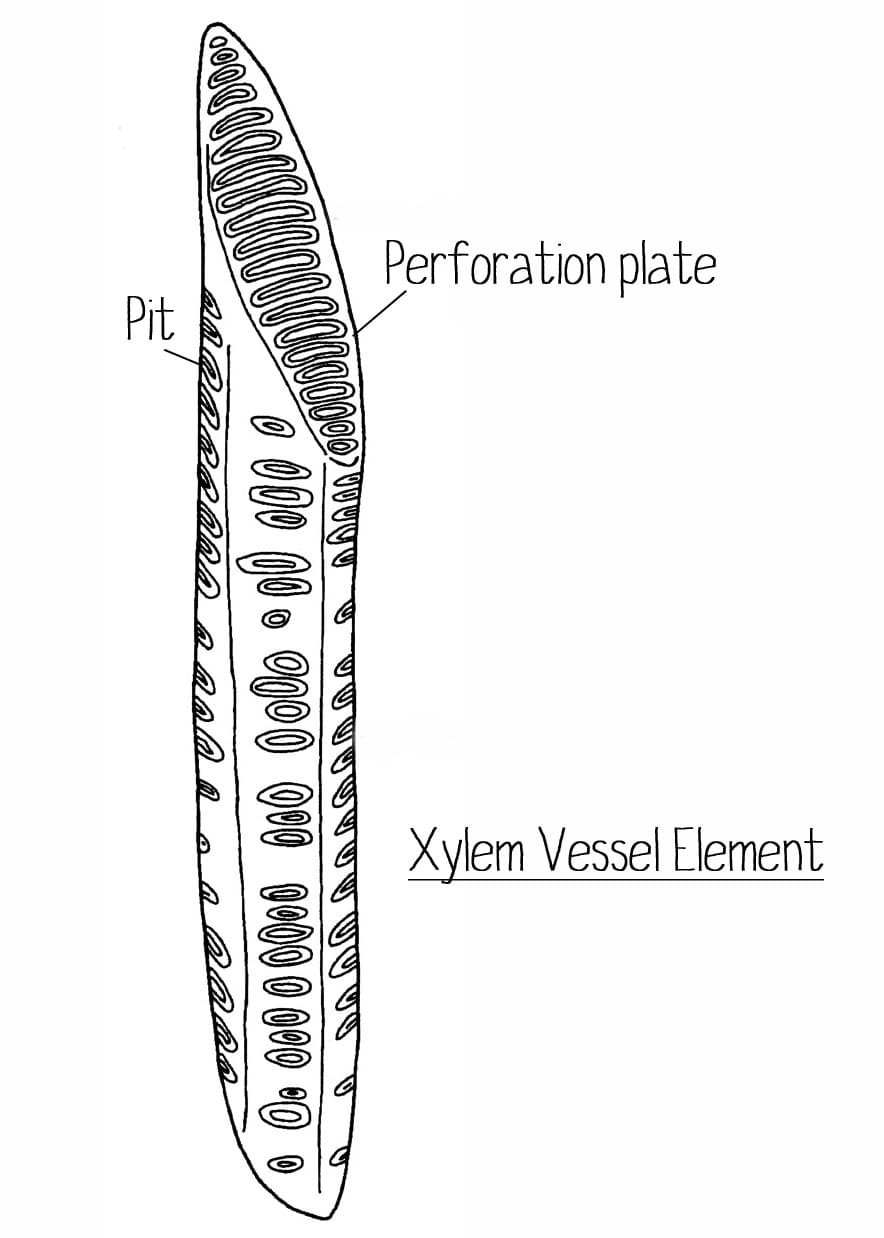PLANT TAXONOMY, STRUCTURE & FUNCTION: Level 3 – Wednesday 13 February 2013
Q.2.a Describe a xylem vessel element. (5 marks)
b. Explain how xylem tissue is adapted for its function in the plant. (5 marks)
Examiner’s Comments
“Candidates who described the physical attributes of a xylem vessel element in detail, in some instances including an annotated diagram, gained high marks for part a). Part b) asked candidates to explain how xylem tissue is adapted for its function and answers could have included an explanation of the function and structure of xylem parenchyma and sclerenchyma fibres as well as the xylem vessel elements. For the vessel elements, candidates could have referred to the lack of cell contents and breakdown of end-walls to make flow easier and reinforcement of the cell wall to withstand pressure without collapsing.”
Discussion of Answers
Q.2.a Describe a xylem vessel element.
The examiners comment that an annotated diagram was a good addition to this answer. As a general guide, diagrams are extremely useful – they convey a lot of information accurately and are often quicker to produce than a written description conveying the same information. In the exam they show the examiner that you have a good understanding of the subject. If relevant to the question, we’d always recommend including a diagram in your answer.
Sample answer:
A xylem vessel element is one of the cell types found in xylem (the water conducting tissue of plants). Xylem tissue contains two types of conducting cells, tracheids and vessel elements. The vessel elements are tube-like and stacked end-to-end to form long, strawlike vessels. At maturity, vessel elements have no cellular contents and consist mainly of thickened secondary walls. Vessel elements develop from undifferentiated living plant cells which have cellulose walls. The cells become elongated and their walls become impregnated with lignin – a process known as lignification. Lignin is a complex non-carbohydrate polymer which is laid down unevenly on the primary cellulose walls of the vessel. Almost the entire inner surface of the primary wall is covered by secondary wall, except for small areas called pits. The pit is not a hole in the wall, but a small, circular area without secondary thickening. Pits occur in pit-pairs with the pits of neighbouring cells precisely aligned to allow for easier movement of water and dissolved substances from one vessel to the next. The middle lamella and the two primary walls between the two pits together make up the pit membrane. The end walls of vessel elements are modified into perforation plates (see diagram). Most vessel elements possess simple transverse perforation plates with only one large perforation, but compound perforation plates with two or more perforations also occur.
(This answer could be expanded further by discussing dfferent forms of secondary thickening.)

b. Explain how xylem tissue is adapted for its function in the plant.
When tackling questions of this sort, begin by picking out key words:
‘Explain’ – which suggests an indepth discussion is needed.
‘Function’ – a good answer to this question will begin by describing the function of xylem tissue and then explaining how it is adapted to fulfil this function.
Students who did not read this question carefully, assumed that it referred only to the xylem vessel elements discussed in ‘a’ and did not provide a full answer.
Sample answer:
Xylem is the tissue in vascular plants that conducts water and inorganic substances from the roots to the above ground parts of the plant, and out the stomates. Xylem contains a number of cell types:
- Conducting cells, often referred to as tracheary elements. There are two types:* tracheids – these are long, tapering cells adapted for water transport and support within the xylem. The cell walls of tracheids are thickened and lignified, with multiple pits that allow for water movement through the plant. The thickened walls mean that tracheids are also strong and adapted to play a supporting role within the xylem.
* vessel elements – these are adapted for rapid water conduction through the plant. They have a large lumen and perforated end plates, reducing resistance to water movement, and when stacked end to end form a vessel, allowing for relatively free movement of water through the vessel. Secondary thickening means that the vessel elements are structurally strong and able to withstand the physical stress of continuous water movement without collapsing.
- Xylem parenchyma cells store water, mineral nutrients and carbohydrates, and respond to wounding by forming callus. Xylem parenchyma are living at maturity, allowing them to fulfil these functions. They can also regenerate functional xylem cells. . These cells are responsible for most of the storage function of xylem. Many xylem parenchyma cells have secondary lignified walls, particularly in woody plants, which allows them to play a stuctural support role. In other cases, these cells have thin, primary walls with areas of plasmodesmata, called primary pit fields, through which cell-to-cell movement of water and mineral nutrients can take place. In woody plants, the parenchyma cells are arranged in narrow columns, known as xylem rays, which extend from the vascular cambium to very near the centre of the tree trunk. The function of xylem rays is to transfer aqueous material horizontally along the diameter of the tree, at a right angle to the flow of water in vessel elements and tracheids. The xylem parenchyma are also distributed throughout the tracheids and vessel elements.
- Xylem sclerenchyma cells are adapted to provide mechanical support, defence and water transport. There are two types of sclerenchyma in xylem – Fibres are long, narrow sclerenchyma cells, mostly with thick secondary walls. They are mainly involved in the mechanical support function of xylem and defence against pathogens and herbivores. Sclereids are a reduced form of sclerenchyma cells with highly thickened, lignified cellular walls,that form small bundles of strengthening tissue within the xylem. Sclerids are typically shorter than fibres,and are usually dead at maturity.
Top image – cross-section of plant stem showing xylem


